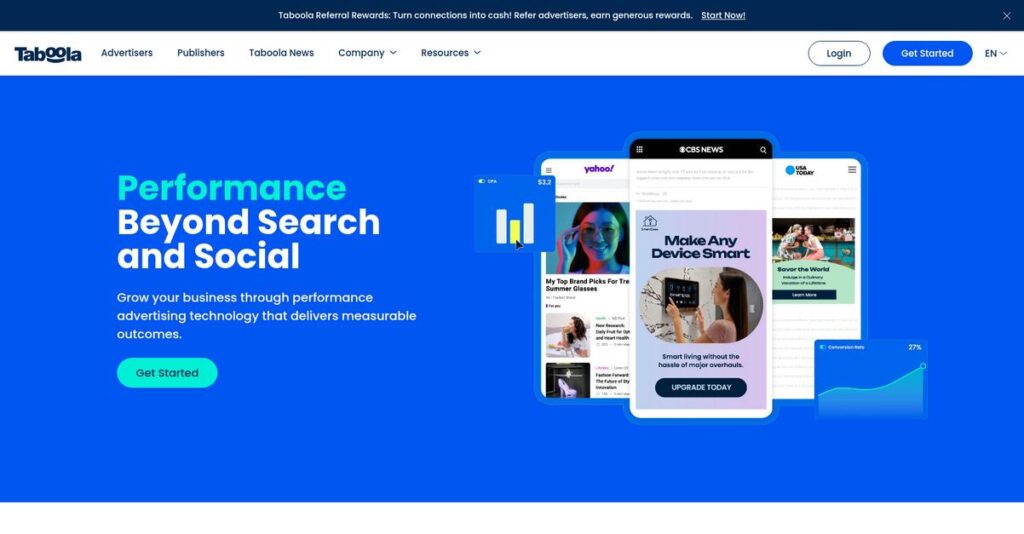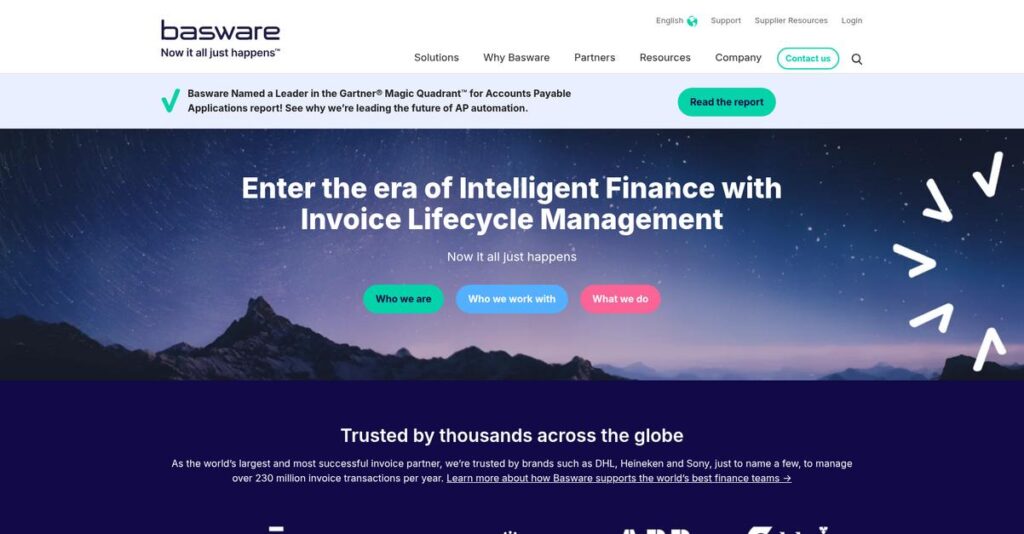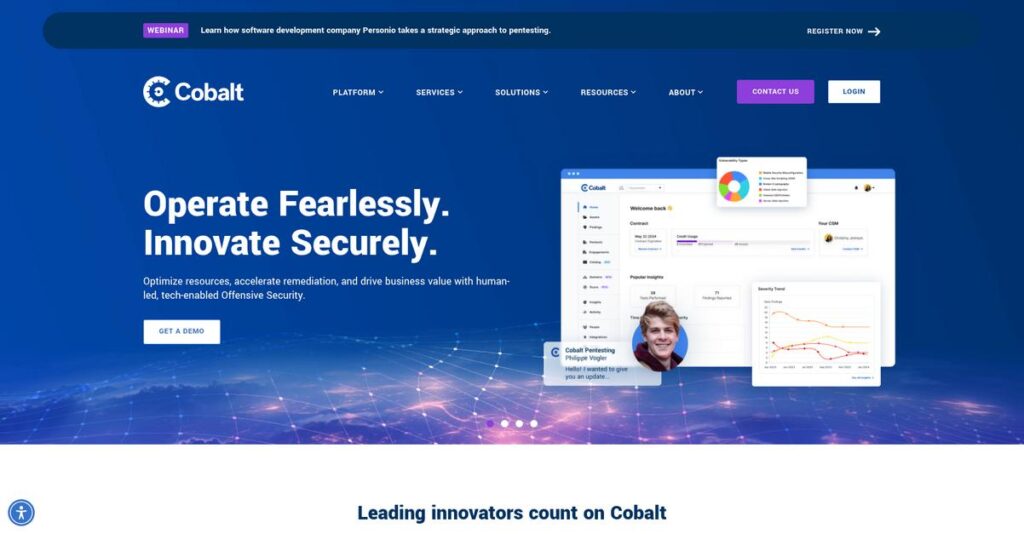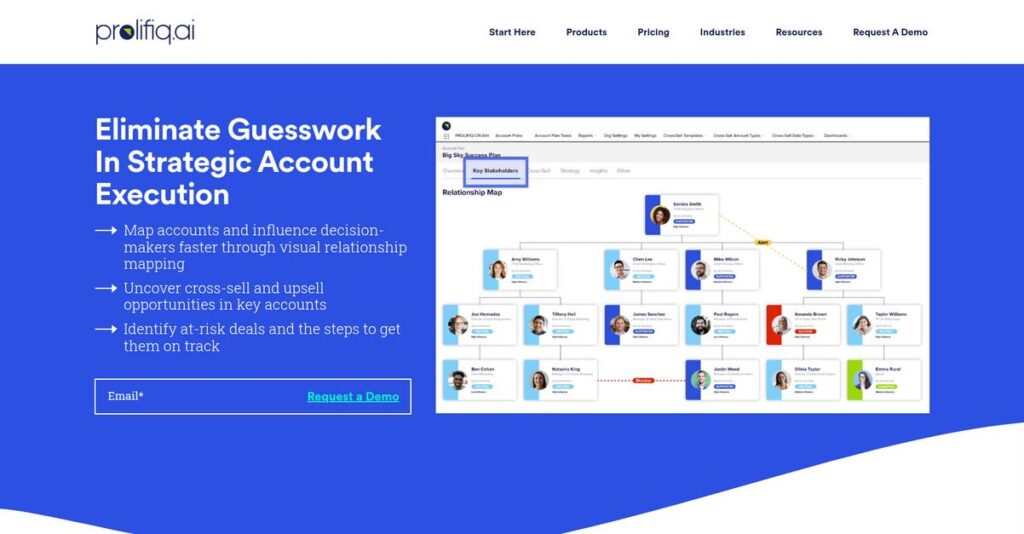Struggling to get your content seen online?
If you’re like most digital marketers or publishers, breaking through the noise to drive meaningful traffic and engagement is an uphill battle.
The real headache? Wasted ad budgets and underperforming campaigns are draining your team’s time and results every day.
Taboola promises a smarter fix, using advanced AI to put your content and offers in front of people who are ready to engage, whether you’re a publisher focused on retention or an advertiser chasing conversions. This isn’t just another generic ad platform—it’s packed with features like Realize for performance outcomes, DeeperDive for AI-driven engagement, and unmatched audience reach via 9,000+ publishers.
In this review, I’ll break down how Taboola can actually drive results that matter for your bottom line.
You’ll get a complete Taboola review covering core features, pricing, the latest 2025 updates, pros/cons, and key alternatives for your evaluation journey.
You’ll come away with the features you need to drive smarter advertising and make a confident choice.
Let’s get started.
Quick Summary
- Taboola is an AI-powered native advertising and content recommendation platform for publishers and advertisers.
- Best for businesses seeking to expand reach and monetize content through native ads on the open web.
- You’ll appreciate its large publisher network and AI-driven targeting that helps drive traffic and conversions.
- Taboola offers cost-per-click pricing with no public free trial, requiring direct contact for demo and quotes.
Taboola Overview
Taboola has been a major player in content recommendations since its 2007 founding. Now headquartered in New York City, their entire mission is powering discovery for the open web.
- 🎯 Bonus Resource: Before diving deeper into content recommendations, you might find my analysis of fire department software helpful.
They serve a massive market, connecting digital publishers with advertisers of all sizes. What truly sets them apart is their commitment to the entire open web, helping you reach potential customers outside of social media’s closed ecosystems.
With the acquisition of e-commerce arm Connexity and the recent “Realize” platform launch, their strategic push into performance advertising is clear, a key point through this Taboola review.
Unlike competitors like Google, which prioritizes display ads, Taboola’s core strength is its native content discovery engine. I find this makes your campaigns feel less like an interruption and more like a genuinely helpful recommendation for readers.
They work with an impressive network of over 9,000 global publishers, so your ads can appear on major news sites like Bloomberg and NBC News, not just smaller, unknown blogs.
From my analysis, their current strategy is a direct response to the diminishing returns advertisers face on social media. They’re providing powerful, performance-focused tools that align perfectly with your need for more efficient and predictable customer acquisition channels outside of Google/Meta.
Let’s dive into their features.
Taboola Features
Still struggling to get your content seen online?
Taboola features are all about helping publishers and advertisers connect with audiences across the open web. Here are the five main Taboola features that can transform your content strategy.
1. Native Advertising Platform (Taboola Ads)
Are your ads blending in, or sticking out like a sore thumb?
Traditional ads often interrupt the user experience, leading to low engagement. This means your message might get ignored, or worse, irritate potential customers.
Taboola Ads places your content directly within publisher articles, making it feel like part of the editorial flow. From my testing, the seamless integration vastly improves ad reception, which is crucial for building trust. This feature uses AI to ensure your promotions are relevant to the surrounding content.
This means you can reach a massive, engaged audience that’s actually receptive to your message, driving higher click-through rates.
2. Content Recommendation Engine
Are visitors leaving your site too quickly?
Low engagement means users bounce without exploring more of your content. This can significantly reduce page views and hurt your overall ad revenue potential.
Taboola’s Content Recommendation Engine keeps users on your site longer by suggesting highly relevant articles and videos. What I love about this approach is how it learns user behavior to personalize recommendations, truly boosting engagement. This feature helps maximize the value of every visitor to your site.
So you can actually see increased time-on-site and improved audience retention, making your content work harder for you.
3. Taboola Realize
Are your performance ad campaigns falling flat?
Many advertisers struggle to achieve specific outcomes like sales or leads from their ad spend. This often leads to wasted budget and frustration with diminishing returns on other platforms.
Taboola Realize focuses purely on performance, leveraging AI and first-party data to optimize for real business results. Here’s where Taboola shines: it unifies diverse inventory for precise targeting. This feature helps you scale campaigns across various formats, from native to display, on high-profile sites.
This means you could achieve higher conversions and a better ROI, moving beyond just clicks to measurable business growth.
4. Taboola DeeperDive
Is your valuable content being lost in the search abyss?
Users often leave publisher sites to search for answers elsewhere. This causes a loss of direct engagement and missed monetization opportunities on your own content.
Taboola DeeperDive is a generative AI answer engine that provides instant answers directly from your site’s content. What I found impressive is how it leverages your own articles to answer user questions, keeping them on your domain. This feature helps you retain audience attention and create new, high-intent ad placements.
So you can keep your audience engaged longer, drive new revenue, and position your site as a go-to source for reliable information.
5. Advanced Targeting Options
Are you still guessing who your ideal audience is?
Generic ad targeting wastes budget by showing your message to the wrong people. This leads to poor campaign performance and a low return on your investment.
Taboola provides robust targeting capabilities, letting you precisely define your audience based on interests, demographics, and behavior. From my testing, the lookalike audiences feature is particularly powerful for expanding reach intelligently. This feature ensures your ads are seen by those most likely to convert.
This means you can optimize your ad spend by reaching highly relevant users, leading to more efficient campaigns and better results.
- 🎯 Bonus Resource: Before diving deeper, you might find my analysis of best legal hold software helpful.
Pros & Cons
- ✅ Excellent for reaching wide audiences with native advertising across the open web.
- ✅ AI-powered content recommendations genuinely boost on-site engagement for publishers.
- ✅ New Realize platform offers strong focus on measurable performance advertising outcomes.
- ⚠️ Some users report challenges with the overall quality of traffic generated.
- ⚠️ Revenue generated can be lower compared to platforms like Google AdSense for publishers.
- ⚠️ The platform may have a learning curve for optimizing advanced campaign features.
You’ll appreciate how these Taboola features work together to provide a comprehensive content and ad ecosystem, whether you’re a publisher or an advertiser.
Taboola Pricing
Confused about what you’ll actually pay monthly?
Taboola pricing is primarily based on a custom CPC model for advertisers, meaning you’ll need to contact sales for a tailored quote, but you only pay when a user clicks your ad.
Cost Breakdown
- Base Platform: Custom quote (CPC model)
- User Licenses: Not applicable (advertiser CPC)
- Implementation: Likely minimal; integrates with existing workflows
- Integrations: Varies by complexity (e.g., third-party audience targeting)
- Key Factors: Targeting options, bid strategy, ad placement, volume
1. Pricing Model & Cost Factors
Understanding their pricing approach.
Taboola operates on a Cost-Per-Click (CPC) model for advertisers, so you pay only when your ad gets clicked. What I found regarding pricing is that costs fluctuate based on targeting and bid strategy, like using “Smart Bid” or adding third-party audience data.
From my cost analysis, this means your ad spend directly ties to engagement, optimizing your budget for clicks.
- 🎯 Bonus Resource: Speaking of cutting fees, if you’re also exploring digital assets, my article on NFT Creation Software covers ways to master minting and cut your costs.
2. Value Assessment & ROI
Is this pricing worth it?
Taboola’s value comes from its vast publisher network and AI-driven recommendations, connecting your content with relevant audiences on the open web. What makes their pricing different is that you’re paying for actual user engagement, not just impressions, which can lead to higher ROI compared to other ad platforms.
This helps you ensure your ad budget is directed towards measurable outcomes, benefiting your marketing efforts.
3. Budget Planning & Implementation
Watch out for hidden expenses.
While Taboola’s CPC model offers flexibility, your campaign goals and desired reach. What I found regarding pricing is that CPC rates can vary based on competition and ad quality, so plan for continuous optimization.
So for your business, you should monitor your campaigns closely to ensure your budget is delivering effective results.
My Take: Taboola’s pricing centers on a performance-based CPC model, making it ideal for advertisers focused on driving clicks and engagement across a massive publisher network rather than fixed monthly fees.
The overall Taboola pricing reflects performance-based value with cost-per-click transparency.
Taboola Reviews
What do real customers actually think?
To help you understand real-world experiences, I’ve analyzed Taboola reviews from various platforms, extracting key insights into user satisfaction, praise points, and common frustrations.
- 🎯 Bonus Resource: Speaking of refining operations, check out my guide on best waitlist software.
1. Overall User Satisfaction
User sentiment is quite mixed.
From my review analysis, Taboola generally receives moderate satisfaction ratings, averaging around 2.9 out of 5 stars on G2 and 6.4 out of 10 on TrustRadius. What I found in user feedback is that satisfaction often correlates with specific campaign goals and expectations, influencing overall sentiment in the reviews.
This suggests your experience will heavily depend on your advertising objectives.
2. Common Praise Points
Audience reach is a consistent highlight.
Users frequently praise Taboola for its ability to generate website traffic and reach audiences inaccessible via other platforms. What stands out in customer feedback is how Taboola expands reach to non-traditional advertising channels, especially for native ad campaigns, which is a common theme in the reviews.
This means you can expect to tap into a broader, often underserved, audience segment.
3. Frequent Complaints
Traffic quality is a common concern.
A recurring issue among users is the perceived low quality of traffic generated, with some describing it as “second-tier traffic.” What I found in user feedback is how revenue generated often falls short of expectations compared to competitors like Google AdSense, as noted in many reviews.
These challenges are important to consider but might not be deal-breakers for all use cases.
What Customers Say
- Positive: “Taboola Is Great For Targeting A Wider Audience & Getting Results. It helps us target users that we otherwise would not be able to show ads.” (G2)
- Constructive: “Not impressive, but it gets the job done for generating second-tier traffic.” (TrustRadius)
- Bottom Line: “Revenue generated from Taboola can be significantly lower than from platforms like Google AdSense.” (G2)
The overall Taboola reviews show a mixed picture, suggesting it’s a viable option for specific goals, but manage your expectations on traffic quality and revenue.
Best Taboola Alternatives
Deciding on the right native advertising partner?
The best Taboola alternatives include several strong options, each better suited for different business situations, budget considerations, and traffic acquisition priorities you might have.
1. Outbrain
Seeking premium publisher placements for branding?
Outbrain excels when your primary goal is to target a highly premium audience on top-tier news sites and blogs. What I found comparing options is that Outbrain focuses on premium publisher relationships, often resulting in a more visually appealing user interface and consistent ad quality as an alternative.
Choose Outbrain if your brand prioritizes reaching an elite audience and values the CPE (Cost-Per-Engagement) model.
2. Google AdSense
Prioritizing maximum direct ad revenue for publishers?
AdSense is the preferred choice if your primary goal is maximizing direct ad revenue per click and you meet Google’s content quality standards. From my competitive analysis, AdSense typically offers substantially higher revenue per click for publishers, supporting a wider range of content beyond just editorial as an alternative.
You should choose Google AdSense if your main focus is on maximizing immediate ad monetization.
- 🎯 Bonus Resource: While we’re discussing optimizing various aspects of your business, understanding how IVR software can boost your clarity is equally important.
3. MGID
Diversifying traffic sources with aggressive lead generation?
MGID might be chosen for campaigns targeting specific niche audiences or for diversifying traffic sources beyond Taboola’s network. From my analysis, MGID provides global reach with diverse traffic sources, particularly appealing if you’re looking for more aggressive angles in lead generation campaigns.
Consider this alternative if you need to explore new traffic verticals or niche audiences not covered elsewhere.
4. Revcontent
Focusing on extremely high-quality content placements?
Revcontent could be an alternative if your brand prioritizes extremely high-quality placements and is willing to potentially pay a bit more for highly engaged audiences. Alternative-wise, Revcontent is known for its stricter publisher approval, aiming to maintain a very premium network and driving better engagement.
Choose Revcontent if your priority is brand safety and reaching highly engaged users through premium content.
Quick Decision Guide
- Choose Taboola: Broad reach for content discovery and direct response campaigns
- Choose Outbrain: Premium publishers and CPE model for branding
- Choose Google AdSense: Maximize direct ad revenue, broad network
- Choose MGID: Niche audience targeting and traffic source diversification
- Choose Revcontent: High-quality placements and highly engaged audiences
The best Taboola alternatives depend on your specific advertising goals and target audience, rather than generic feature sets.
Taboola Setup
How complex is Taboola to implement?
Taboola implementation involves either setting up ad campaigns or integrating widgets. From my Taboola review, the process is generally user-friendly, setting realistic expectations for a manageable deployment.
1. Setup Complexity & Timeline
Not a simple, one-size-fits-all rollout.
For advertisers, setup involves dashboard configuration, campaign details, targeting, and creative uploads, which is straightforward. Publishers, however, need to integrate widget code; Taboola implementation hinges on your role. What I found about deployment is that content approval can introduce variable timelines for publishers.
You’ll need to allocate time for campaign optimization or website integration, depending on your business type.
2. Technical Requirements & Integration
Expect some technical involvement for publishers.
Taboola’s technical requirements primarily involve integrating code onto your website or mobile application. What I found about deployment is that it handles complex recommendation logic through its AI engine, minimizing your server-side burden. Advertisers typically use the dashboard without deep technical integration.
Plan for web development resources if you’re a publisher, but advertisers will find the technical barrier quite low.
3. Training & Change Management
User adoption is generally intuitive.
Training needs for Taboola are manageable due to its intuitive interface, providing in-platform performance suggestions for advertisers. From my analysis, the platform’s usability reduces the learning curve for both advertisers and publishers, making adoption relatively smooth compared to more complex systems.
Focus on leveraging the in-platform tools and analytics for campaign optimization, rather than extensive, formal training sessions.
4. Support & Success Factors
Vendor support can significantly aid your rollout.
Taboola’s support quality is generally well-regarded by users, suggesting adequate assistance throughout your implementation and ongoing use. From my analysis, quality vendor support is critical for success, particularly if you encounter specific integration challenges or campaign optimization questions.
Plan to leverage their support resources, consistently monitor performance, and optimize campaigns to achieve your desired outcomes.
Implementation Checklist
- Timeline: Weeks for publishers, days for advertisers
- Team Size: Marketing for ads; web dev for publisher integration
- Budget: Primarily ad spend for advertisers; staff time for publishers
- Technical: Website code integration (publishers); dashboard use (advertisers)
- Success Factor: Consistent campaign optimization and content engagement
Overall, Taboola setup is generally accessible, but success hinges on consistent optimization and understanding your specific use case as an advertiser or publisher.
Bottom Line
Is Taboola your next content discovery partner?
This Taboola review synthesizes my analysis to provide a clear recommendation, helping you understand its overall value proposition for your specific business needs.
- 🎯 Bonus Resource: If you’re exploring diverse business tools, my guide on best arborist software can uncomplicate your operations.
1. Who This Works Best For
Publishers and advertisers seeking open web reach.
Taboola shines for digital content creators and marketing teams aiming to expand audience reach and monetize content beyond traditional platforms. What I found about target users is that e-commerce, retail, and media companies leveraging content-driven ads benefit most from its native formats.
You’ll succeed if you prioritize diversifying ad channels and utilizing AI for personalized content recommendations.
2. Overall Strengths
Unparalleled reach across the open web.
The platform truly excels in providing massive reach and advanced targeting capabilities for native advertising and content discovery. From my comprehensive analysis, Taboola’s AI-powered recommendation engine seamlessly integrates ads within editorial content, offering a less intrusive user experience compared to traditional display ads, fostering higher engagement.
These strengths allow you to tap into new audience segments, drive traffic, and effectively monetize your digital content.
3. Key Limitations
Traffic quality and revenue concerns persist.
Users frequently report “second-tier traffic” quality, and publishers often cite significantly lower revenue per click compared to alternatives like Google AdSense. Based on this review, strict content requirements can also be a challenge for certain types of content, demanding careful compliance and campaign planning from your team.
While these limitations require consideration, they are manageable trade-offs if Taboola’s unique audience reach aligns with your primary marketing goals.
4. Final Recommendation
Taboola is a strong contender for specific needs.
You should choose this software if your goal is to expand audience reach through native advertising and monetize content via AI-driven recommendations. From my analysis, diversifying ad spend beyond Google and Facebook is where this solution truly shines for both advertisers and publishers.
My confidence level is high for businesses prioritizing native ad formats and seeking new avenues for audience engagement.
Bottom Line
- Verdict: Recommended with reservations for specific use cases
- Best For: Publishers and advertisers expanding content monetization and reach
- Business Size: Small to large brands, particularly in e-commerce and media
- Biggest Strength: Massive open web reach and AI-powered native recommendations
- Main Concern: Traffic quality and lower revenue per click for publishers
- Next Step: Explore a demo to assess fit for your content and audience strategy
This Taboola review reveals strong value for open web content discovery, but also highlights areas for careful consideration regarding traffic quality and potential revenue comparisons.





